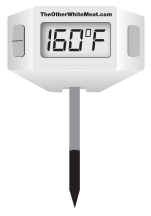Cues for the Conscientious Cook
Use an instant-read thermometer to determine when meat is cooked to a safe temperature. Correctly cooked pork is juicy and tender,
with a slight blush of pink in the center and will be ready when it reaches an internal temperature of 160° F. For large cuts of pork, cook to 150° F and allow the roast to sit on the counter about 10 minutes before cutting. The temperature will rise to 160° F.- Keep hot foods hot (140° F or above) and cold foods cold (40° F or below).
- Never leave cooked meat out at room temperature for more than two hours (one hour in hot weather 90° F or above).
- Serve cooked food on a clean plate and use clean utensils. Use separate serving plates and utensils for raw and cooked meats.
A Plan for Preparation
Wash hands, all utensils, containers, cutting boards and work surfaces with warm soapy water for 20 seconds (count to 30) before
and after handling meat or other food.- Thaw meat in the refrigerator or microwave, not at room temperature.
- Do not wash raw meat before cooking. • Cook meat immediately after thawing, especially if thawed by microwaving.
- Cut meat, poultry and fish on a separate cutting board from the one you use for fresh foods like vegetables, or thoroughly clean the cutting board between uses.
Pork Fits into a Healthy Diet
Leaner than ever – USDA research reveals that six of the most common cuts of pork are 16 percent leaner and contain 27 percent less saturated fat than they did 19 years ago. As a lean protein option, pork can be part of heart-healthy diet.
Protein power – Women who cut calories but included more protein, including six ounces of lean pork per day, kept more muscle mass while losing weight than women who consumed the same amount of calories but less protein. Consuming a higherprotein diet also helped retain a sense of satiety or fullness after meals.
Nutrient rich – One serving of pork tenderloin contains many vitamins and minerals. It’s an excellent source of many B-vitamins and a good source of other nutrients including phosphorus, zinc and potassium. It’s also naturally low in sodium – only 2 percent of the Daily Value per serving.
Cues for the Conscientious Cook
Use an instant-read thermometer to determine when meat is cooked to a safe temperature. The U.S. Department of Agriculture recommends that pork be cooked to an internal temperature of 145° F, followed by a three-minute rest time (medium-rare), up to 160° F (medium). This range of cooking will result in a flavorful, tender and juicy eating experience.
- Keep hot foods hot (140° F or above) and cold foods cold (40° F or below).
- Never leave cooked meat out at room temperature for more than two hours (one hour in hot weather 90° F or above).
- Serve cooked food on a clean plate and use clean utensils. Use separate serving plates and utensils for raw and cooked meats.
A Plan for Preparation
Wash hands, all utensils, containers, cutting boards and work surfaces with warm soapy water for 20 seconds (count to 30) before and after handling meat or other food.
- Thaw meat in the refrigerator or microwave, not at room temperature.
- Do not wash raw meat before cooking.
- Cook meat immediately after thawing, especially if thawed by microwaving.
- Cut meat, poultry and fish on a separate cutting board from the one you use for fresh foods like vegetables, or thoroughly clean the cutting board between uses.
Pork Fits into a Healthy Diet
Leaner than ever – USDA research reveals that six of the most common cuts of pork are 16 percent leaner and contain 27 percent less saturated fat than they did 19 years ago. As a lean protein option, pork can be part of heart-healthy diet.
Protein power – Women who cut calories but included more protein, including six ounces of lean pork per day, kept more muscle mass while losing weight than women who consumed the same amount of calories but less protein. Consuming a higherprotein diet also helped retain a sense of satiety or fullness after meals.
Nutrient rich – One serving of pork tenderloin contains many vitamins and minerals. It’s an excellent source of many B-vitamins and a good source of other nutrients including phosphorus, zinc and potassium. It’s also naturally low in sodium – only 2 percent of the Daily Value per serving.
Pork Cooking Times and Temperatures
| Method | Cut | Thickness/ Weight | Internal Temp. Followed By a Three-Minute Rest | Average Recommended Cooking Time (minutes per pound OR total minutes) |
| Roasting Roast at 350° F., unless otherwise noted. Roast in a shallow pan, uncovered |
Loin Roast, Bone–In or Boneless* | 2–5 lbs. | 145° | 20 minutes per lb. |
| Crown Roast* | 10 lbs. | 145° | 12 minutes per lb. | |
| Fresh Leg/Uncured Ham* | 18-20 lbs. | 145° | 15 minutes per lb. | |
| Tenderloin* (roast at 425°F.) | ½–1½ lbs. | 145° | 20-27 minutes total time | |
| Ribs | — | Tender | 1½–2 hours | |
| Ham, fully cooked | 5–6 lbs. | 140° | 20 minutes per lb. | |
| Broiling 4-5 inches from heat OR Grilling over direct medium heat; turn once halfway through grilling |
Loin Chops, Bone–In or Boneless | ¾ inch | 145° | 8–9 minutes |
| Thick Chop | 1½ inches | 145° | 12–16 minutes | |
| Loin Kabobs | 1 inch cubes | Tender | 10–15 minutes | |
| Tenderloin | ½–1½ lbs. | 145° | 20 minutes | |
| Ground Pork Patties | ½–inch | 160° | 8–10 minutes | |
| Barbecuing over indirect medium heat (285° F.) |
Loin Roast, Bone–In or Boneless* | 2–5 lbs. | 145° | 2 lbs. roast = 20 minutes per lb. 3½–5 lbs roast = 15 minutes per lb. |
| Shoulder (Butt)* | 3–6 lbs. | Tender | 45 minutes per lb. | |
| Ribs | – | Tender | 1½–2 hours | |
| Sautéing Add a little cooking oil to pan; sauté over medium-high heat and turn once halfway through cooking time |
Cutlets | ¼ inch | Tender | 3–4 minutes |
| Loin Chops, Bone–In or Boneless | ¾ inch | 145° | 8 minutes total | |
| Tenderloin Medallions | ¼–½ inch | Tender | 4–8 minutes total | |
| Ground Pork Patties | ½ inch | 160° | 8–10 minutes total | |
| Stewing Cook, covered, with liquid at a slow simmer |
Loin or Shoulder Cubes | 1 inch | Tender | 45 minutes–1 hour |
Pork today is very lean and shouldn’t be overcooked. To check doneness, use a digital cooking thermometer. The National Pork Board follows the guidance of the U.S. Department of Agriculture, which recommends cooking roasts, tenderloins and chops to an internal temperature of 145° F, followed by a three-minute rest time, resulting in a flavorful, tender and juicy eating experience. Ground pork, like all ground meat, should be cooked to 160° F. Pre-cooked ham can be reheated to 140° F or enjoyed cold.
*Note: For easier slicing and to let the pork juices redistribute throughout the meat, remove larger cuts, such as roasts, from the oven or grill and let them stand for a total of 10 minutes before serving.
(source)

 Use an instant-read thermometer to determine when meat is cooked to a safe temperature. Correctly cooked pork is juicy and tender,
Use an instant-read thermometer to determine when meat is cooked to a safe temperature. Correctly cooked pork is juicy and tender, Wash hands, all utensils, containers, cutting boards and work surfaces with warm soapy water for 20 seconds (count to 30) before
Wash hands, all utensils, containers, cutting boards and work surfaces with warm soapy water for 20 seconds (count to 30) before

